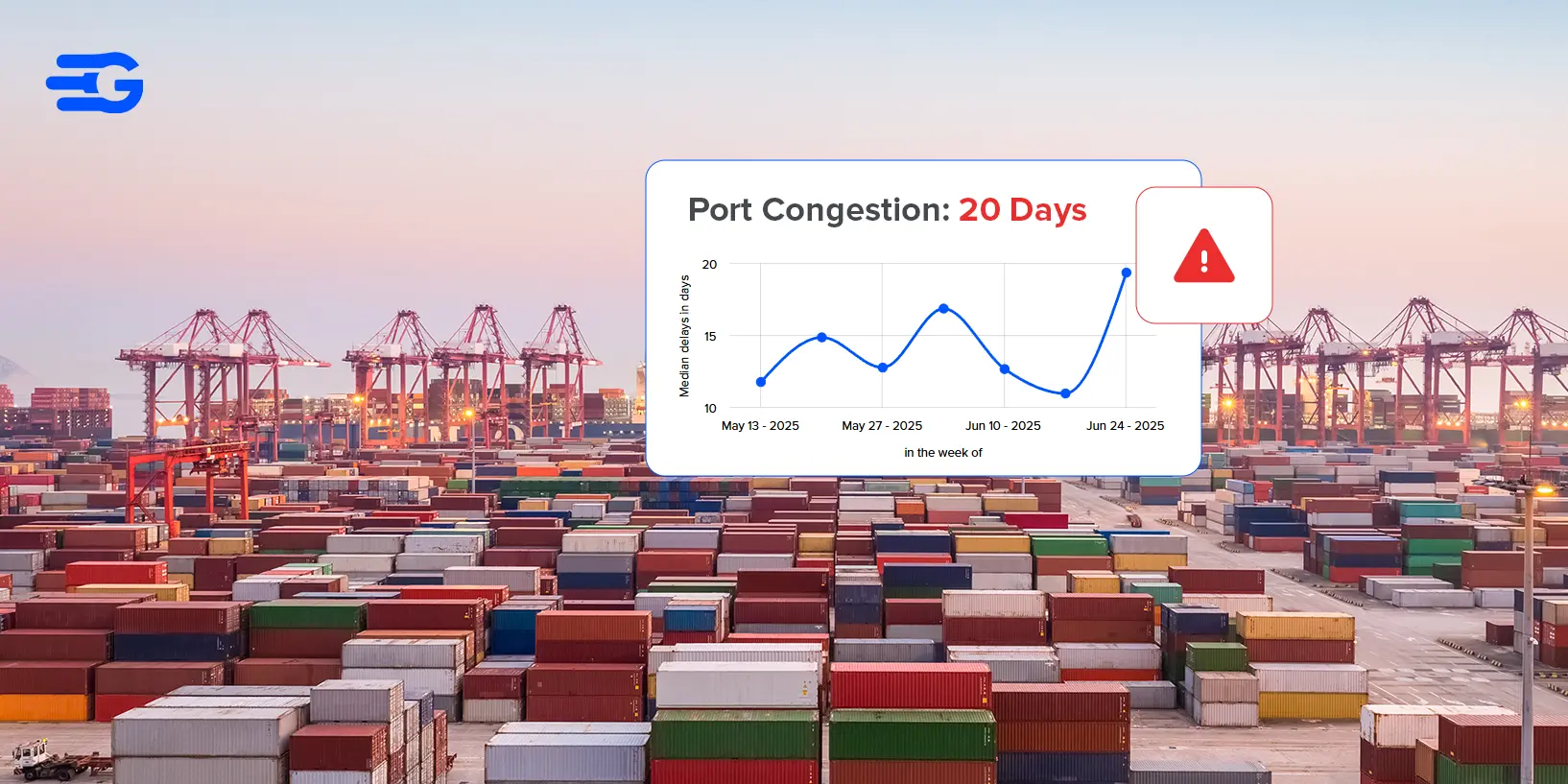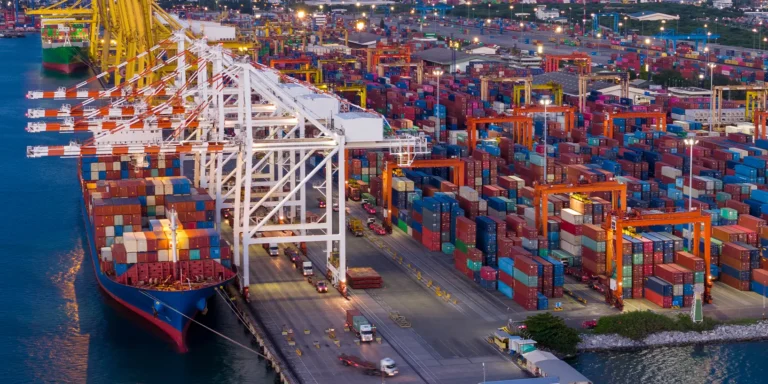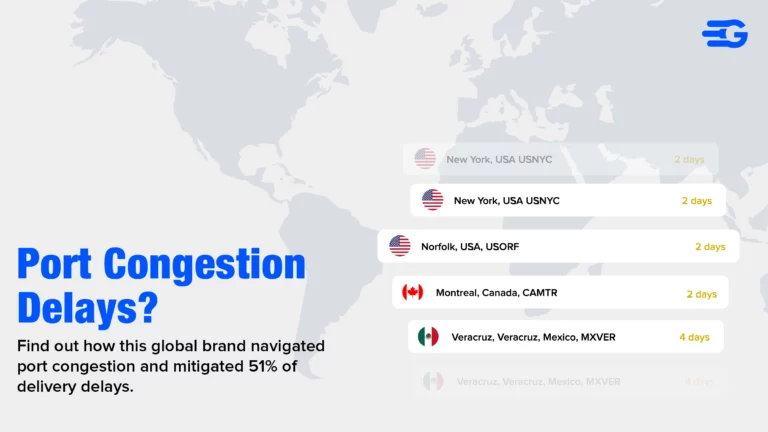What Is Port Congestion?
Port congestion means too many ships and not enough room. It happens when ports can’t handle the number of vessels arriving. Delays in unloading, customs checks, or moving cargo inland make it worse. One of our clients faced a ten-day delay on their shipment from Hamburg to Mumbai due to severe port congestion. That delay disrupted their entire delivery schedule and highlighted the need for better planning and visibility.
When demand spikes and ports aren’t ready, containers pile up fast. This happened in 2020 and 2021. Los Angeles, New York, and Felixstowe couldn’t keep up. Our clients tracked containers daily, hoping for movement.
What Causes Port Congestion?
Multiple operational and external factors can trigger congestion at major ports. These include:
High Cargo Volume During Peak Seasons
Periods like Chinese New Year, year-end holidays, and back-to-school sales see major spikes in container volumes. Ports often struggle to handle this sudden influx efficiently, especially when backlogs already exist. For instance, in late 2021, the ports of Ningbo and Shenzhen experienced major bottlenecks due to increased pre-holiday shipments coupled with pandemic control measures.
Inadequate Infrastructure & Staffing
Older terminals may struggle with container traffic due to poor layout, limited cranes, or inefficient truck access. Without regular upgrades, they fall behind growing global demand.
Regulatory, Customs & Security Delays
Cargo has to go through customs and security checks. If these take too long, containers stay at the port too long, causing traffic and delays.
Regulations vary by country, and inconsistent or manual customs processes add hours or even days. Inspections, paperwork, and miscommunications slow things down.
Labor Disputes & Strikes
When dockworkers or truck drivers go on strike, port operations stop. This leads to a backlog of ships and containers.
Even short-term strikes can take weeks to recover from. Each day of lost time increases congestion, leading to spiraling delays in port and inland supply chains. The 2024 US Port Strike is one such example. Dockworkers went on a 3-day strike that led to a never-before-seen congestion on major US ports.
Weather Events & Disruptions
Bad weather, like storms or floods, can shut down ports. Even short closures delay a lot of shipments.
Natural disasters and extreme conditions like hurricanes, fog, or high winds force ports to suspend operations. The result? Hundreds of containers are stuck in limbo. The Red Sea Crisis is one phenomenon that led many companies to spend thousands of dollars on demurrage and detention charges.
Impacts of Port Congestion
When ports slow down, the effects ripple through the entire supply chain. These are some of the key problems it causes.
Delays in Global Shipping & Increased Lead Times
Ships stuck outside the port delay cargo deliveries. Products arrive late, and businesses can’t keep up with demand.
Lead times increase by days or weeks. That throws off production planning, inventory management, and customer fulfillment.
Higher Shipping Costs & Supply Chain Inflation
Delays mean ships use more fuel. Companies also pay extra fees for late deliveries, raising the cost of goods.
Carriers charge demurrage and detention. Fuel consumption rises as ships reroute. All of these costs get passed down the supply chain.
Shipping costs climb fast. During the 2021 West Coast congestion, detention fees went up to $280 per day. Our platform enabled clients to track detention windows and avoid penalties by taking timely action.
Inventory Shortages & Stockouts
When deliveries are late, stores and factories run out of products. This hurts sales and production.
Just-in-Time inventory models suffer the most. A few late containers can halt entire production lines. Retailers face empty shelves.
Environmental Impacts
Ships and trucks waiting around use more fuel. This creates more air pollution around busy ports.
Idle vessels release CO2 and other pollutants. Congested roads near ports lead to longer truck idle times and higher emissions.
How to Tackle Port Congestion
To support supply chain teams during such challenges, we offer the Port Congestion Tool. This real-time dashboard tracks delays at major global ports and helps companies reroute shipments, set accurate ETAs, and optimize planning. You can explore the live GoComet’s Port Congestion Tool here.
There are several strategies ports and businesses can use to reduce delays and keep cargo moving smoothly. These include investments, process changes, and smarter coordination.
Infrastructure Upgrades & Automation
Ports can add new cranes, better yard layouts, and sensors. Automation speeds up loading and unloading.
AI-powered cranes and automated guided vehicles (AGVs) reduce human error and increase throughput. Expanding dock space and streamlining container stacking also help.
Strategic Scheduling & Vessel Rotation
Spreading out ship arrival times avoids traffic jams. Better scheduling helps ports handle ships more smoothly.
Carriers and terminals can collaborate to balance berthing schedules. Real-time coordination prevents bunching and idle time.
Port Community Systems & Real-Time Tracking
Digital systems help everyone stay updated. Ports, carriers, and customs can share info and prevent delays.
“ETA’s published by the shipping line generally do not reflect the known variables, e.g, Port congestion; therefore, we reached out to GoComet to provide an alternate ETA” – LYCRA
Our tools bring visibility to all stakeholders. From port operators to customers, everyone sees the same data and plans accordingly.
Supply Chain Collaboration & Diversification
Using different ports and transport options spreads out the risk. Working with partners keeps cargo moving even during problems.
Multi-port strategies, inland hubs, and shared visibility dashboards improve flexibility. Shippers gain backup routes when primary ports clog up.
Policy & Regulatory Reforms
Simpler customs processes and faster inspections save time. Clear and fair rules help ports run better.
Digital customs forms, pre-clearance programs, and harmonized procedures reduce friction. Governments can also support 24/7 port operations.
Conclusion
Port congestion remains one of the most disruptive issues in global logistics. From weather and labor strikes to customs delays and geopolitical crises, the causes are many. But so are the solutions.
By using smarter tools like our Port Congestion Dashboard and Predictive ETA engine, businesses can stay ahead of delays, keep customers informed, and plan better. Whether it’s rerouting shipments or adjusting schedules, timely insights make a real difference.
We’re here to help you turn visibility into action and uncertainty into control.


